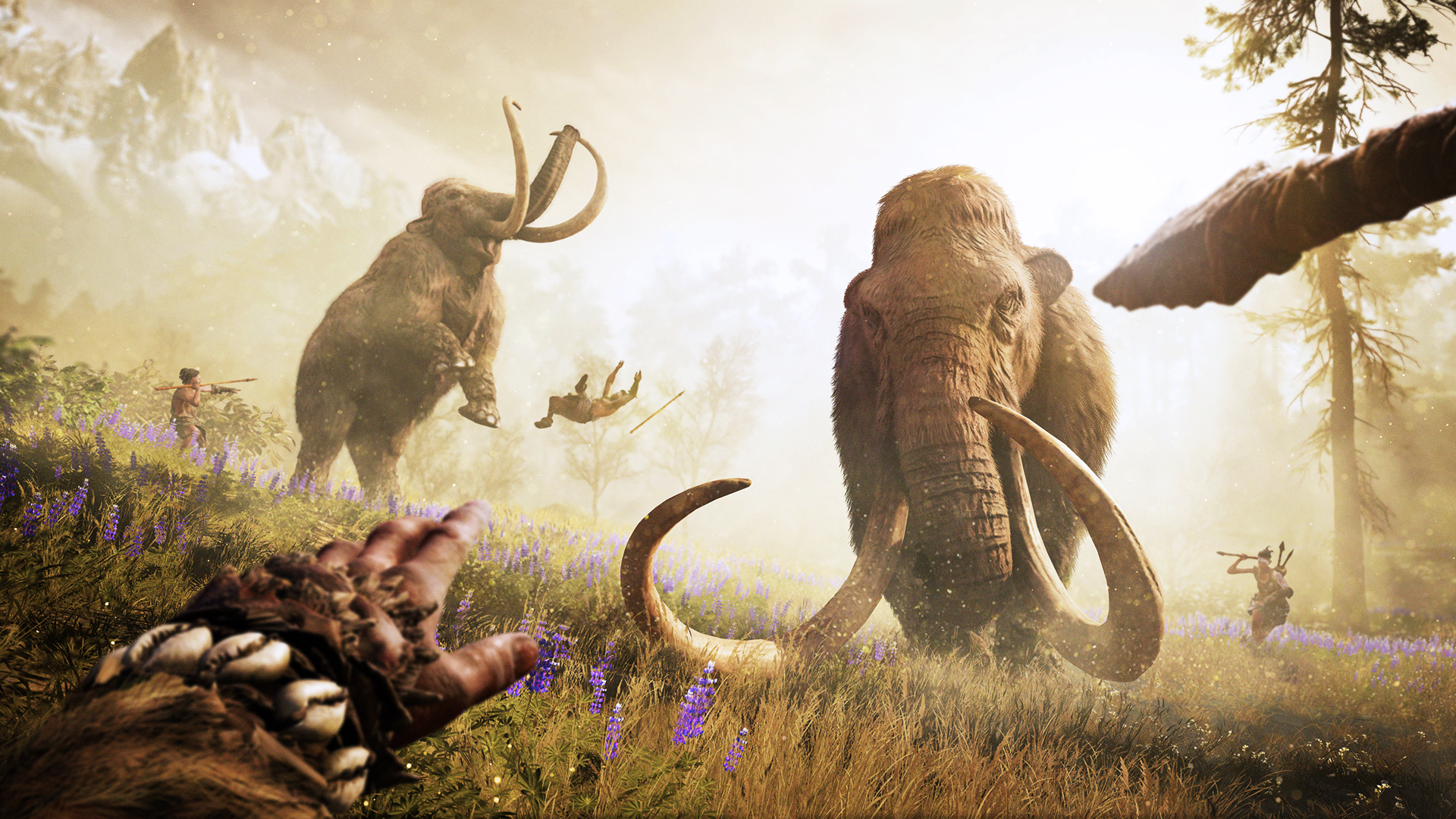Far Cry Primal gameplay: attack of the ancients

The first thing I’m instructed to do in Far Cry: Primal is creep around some feeding wooly mammoths. The second thing I’m instructed to do is kill one. It needs to die because I need to eat, so after some reckless jabbing with my trusty spear, the dignified beast is felled on a serene lookout somewhere in Central Europe.
It’s 10,000 BC. Humanity exists, but we’re gibbering maniacs. Still, we’re evolved enough to know that if we collect a certain number of materials, they will combine to create something useful. To these ends, protagonist Takkar’s third task is to collect five pieces of Alder Wood, two reeds and two pieces of slate in order to craft a bow. Thankfully, all of these materials are within walking distance.
If you hoped Far Cry: Primal was going to play out substantially differently to the last two Far Cry games, then bad news: it doesn’t. Collecting things in order to create other things is still an early game priority. Indeed, the primal survival context ramps up the collecting duties even more. Creating items isn’t a matter of tinkering with resources in your inventory to see what works, like in other, more complex survival games. Takkar needs to ‘learn’ crafting schematas, which are usually trapped behind story beats or level requirements.
So don’t expect this to be Ubisoft’s take on Ark: Survival Evolved. If Takkar dies, he respawns no worse off than before. There’s an abundance of waypoints to explore in order to progress the narrative, and doing so is nice because the land of Oros is a pleasant place to be. Sure, the wildlife is more numerous and dangerous than ever before – sabre-tooth tigers, wolves, wooly mammoths, bears of all sorts – but the towering foliage and dramatically undulating landscapes are beautiful, albeit no more technically advanced than the lands of Far Cry 4.
Calm and collected
After half-hour of exposition, Takkar arrives at the remains of a Wenja settlement. Sayla, a woman he encounters while fleeing from a tiger, wants Takkar to help her rebuild it. Another powerful tribal faction, the Udam, has laid waste to the settlement and are apparently very mean brutes, forcing the Wenja to disperse throughout Oros. It’s Takkar’s job to bring them back and grow the Wenja camp back to its former glory. Only the Udam aren't the only problem: there's a nasty Izila tribe, too, who tend to favour projectile weapons and fire. As important residents are retrieved, each establish their own hut which Takkar can level up for better abilities and goods. It sounds like a lot of micro-management, but based on the three hours I played, it’s more a case of collecting stuff in order to level each hut.
Collecting stuff is kinda annoying, to be honest. Takkar has an instinct toggle that renders his vision monochrome but highlights harvestable items and enemies. I spent most of my time spamming this toggle in pursuit of slate, reeds and other stuff. Let me be clear about this: I don’t mind collecting things, usually. It’s a nice, meditative thing to do. Expect to do a lot of it, though, if you want to build that settlement to its fullest splendour. Expect to do a lot of hunting in pursuit of a specific skin or leather used on a specific hut, and expect to experience a mild existential crisis while doing so.
The busy work doesn’t end there: taming animals is a neat feature in Far Cry: Primal, and anything from yapping dholes through to wooly mammoths (correction: wooly mammoths can't be tamed, according to a Ubisoft source) are available to be enslaved, as well as some larger, rarer beasts that require a bit more investigative work to track down (examples include a snow wolf and a great scar bear). I paraded around with a wolf for the majority of my play time, but you’re able to tame more deadly creatures like sabre-tooth tigers and bears as well, so long as you level the right skill tree.
Keep up to date with the most important stories and the best deals, as picked by the PC Gamer team.

Having spent four hours playing Primal on a PS4, I feel much the same as Shaun. The setting is a refreshing change from the last Far Cry, but at the same time the game doesn’t quite feel different enough. My biggest worry going in was that the combat would be boring, but because your enemies also don’t have guns, there’s actually some dynamism to how you close the distance on them.
That said, the biggest missed opportunity to me is that Takkar just seems like a regular Far Cry dude but without firearms. I was hoping he’d be this super-physical athlete, prowling the countryside, leaping around, with tons of different melee moves. But at close-quarters the fighting is so swishy you might as well be playing Skyrim. Still, I’m interested enough to want to see more, and especially how the PC version holds up.
- Tim Clark, global editor-in-chief
And that’s my beef with Far Cry Primal: levelling systems lend a sense of progress and momentum to a lot of open world games, but here it feels at odds with the setting. If I’m good enough to tame a sabre-tooth tiger early game, why not let me? If I figure out how to craft a better club than the one I have, why do I have to unlock all this other stuff first? These linear progression paths seem at odds with Primal’s pioneering spirit, and there’s a tonne of them: each hut unlocks its own tree. There are 80 skills, all up. I really wanted this world to react to me, but it only did insofar as a certain set of arbitrary conditions were met.
But this is Far Cry. This is to be expected. Except now, there are no guns. This is less of a problem than I originally thought it would be. The Udam are the main human foes you’ll be bludgeoning to death during the opening hours of Far Cry: Primal, and they’re stupid bastards, thankfully. As in the last two Far Cry games, there are also heavies equipped with armour and more powerful melee weapons. There’s a sick joy in bashing people in the head with clubs, and an even sicker joy in siccing your wolf onto an unsuspecting grunt. Doing that is simple: lay the crosshair over an enemy and signal that you want that enemy gone.
An owl sentry replaces binoculars, and this is a much more fun and flexible way of scoping out and marking enemy outposts. During outpost scenarios (yes, they’re back), stealth is just as viable as it has been in previous entries, and the bow-and-arrow – while no match for a sniper rifle – is snappy and precise. The melee weapons feel fine: spears can be either jabbed or thrown, while clubs lay waste with a sturdy impact reminiscent of the melee combat in Dying Light, though that's based on using a PS4 controller: how it holds up with a rumble-less mouse and keyboard is yet to be seen.
There has been some wishful speculation in the office that the second half of Far Cry: Primal will feature an alien invasion, thus leading to some much-craved gunplay. I wouldn’t object to this outcome at all, but I also don’t feel like Far Cry: Primal is a lesser game for not having modern weapons. I do wish that it had even more to distinguish itself from its predecessors, though. Based on my brief time spent with it, Primal is exactly what it looks like on paper, divorced from the colourful sales pitch: it’s Far Cry without guns, and it’s set in 10,000 BC.
This preview is based on PS4 code. A PC version wasn't available at the time of writing.

Shaun Prescott is the Australian editor of PC Gamer. With over ten years experience covering the games industry, his work has appeared on GamesRadar+, TechRadar, The Guardian, PLAY Magazine, the Sydney Morning Herald, and more. Specific interests include indie games, obscure Metroidvanias, speedrunning, experimental games and FPSs. He thinks Lulu by Metallica and Lou Reed is an all-time classic that will receive its due critical reappraisal one day.

